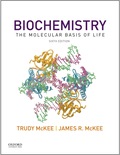
To analyze:
The maximum number of adenosine triphosphate (ATP) molecules generated from a mole of sucrose.
Introduction:
Glycolysis is a process in which glucose is broken down and gets converted to pyruvate. This process leads to the generation of energy. Energy is released in the form of ATP. These ATP molecules help in carrying out other reactions in the body.
Explanation of Solution
Sucrose is a disaccharide made up of two monosaccharides, glucoseand fructose.
For thebreakdown of one mole of glucose, ATP can be calculated at three stages.
1. Glycolysis: 6.5 ATP (2 ATP are utilized in the preparatory phase and 4 ATParereleased by substrate-levelphosphorylation. 4.5 ATPareproduced through the conversion of 2 nicotinamide adenine dinucleotide (NADH) to 2 NAD+ through oxidative phosphorylation)
2. Pyruvate to acetyl-CoA: 5 ATP (2 NADH are converted to 2 NAD+ and 5 ATP are released).
3. Citric acid cycle: 19.5 ATP (6 NADH produce 15 ATP, 2 flavin adenine dinucleotide (FADH2)produce 3 ATP through oxidative phosphorylation and 1.5 ATP molecules are produced through the formation of guanosine triphosphate (GTP) ).
Total ATP generated through glycolysis:
The number of ATP molecules generated during the breakdown of one mole of fructosecan be calculated at three stages.
1. Fructose
After forming fructose 6-phosphate from fructose by Hexokinase IV, it enters in gluconeogenic pathway.
2. Pyruvate to acetyl-CoA: 5 ATP (2 NADH are converted to 2 NAD+ and 5 ATP are released).
3. Citric acid cycle: 19.5 ATP (6 NADH produce 15 ATP, 2 FADH2 produce 3 ATP through oxidative phosphorylation and 1.5 ATP molecules are produced through the formation of GTP).
Total ATP generated through glycolysis:
The breakdown of one mole of sucrose will generate 31 ATP from glucose and 31 ATP from fructose.
Therefore, it can be concluded that the maximum number of ATP that can be generated from one mole of sucrose is 62.
Want to see more full solutions like this?
Chapter 10 Solutions
EBK BIOCHEMISTRY: THE MOLECULAR BASIS O
- How many ATP molecules can be made from glucose in brain and heart tissue, respectively?arrow_forwardArrange these four molecules in increasing order of their biological energy content per mole:(a) Mannose(b) Stearic acid, CH3(CH2)16COOH(c) Fructose(d) Palmitic acid, CH3(CH2)14COOHarrow_forwardCompare the amount of ATP formed during the metabolization of glucose, proteins and a fatty acid (C16H32O16) by means of a table.arrow_forward
- calculate the energy balance of the synthesis of one glucose molecule from two glycerol moleculesarrow_forwardIf you eat a spoonful of sugar (sucrose), propose a mechanism for breaking it down into glucose and fructose.arrow_forwardDescribe the pathway by which glucose is converted into fat.arrow_forward
- Does one molecule of glucose produce 30 or 36 ATP?arrow_forwardArrange the following molecules in order of their biological energy content per mole : glucose, caproic acid, sucrose, myristic acidarrow_forwardDetermine whether the following reactions will proceed favorably or spontaneously. A. fructose-6-phosphate + ATP → fructose-1,6-diphosphate B. glycerol phosphate + ADP → glycerol + ATP C. phosphocreatine + ADP → creatine + ATParrow_forward
 BiochemistryBiochemistryISBN:9781319114671Author:Lubert Stryer, Jeremy M. Berg, John L. Tymoczko, Gregory J. Gatto Jr.Publisher:W. H. Freeman
BiochemistryBiochemistryISBN:9781319114671Author:Lubert Stryer, Jeremy M. Berg, John L. Tymoczko, Gregory J. Gatto Jr.Publisher:W. H. Freeman Lehninger Principles of BiochemistryBiochemistryISBN:9781464126116Author:David L. Nelson, Michael M. CoxPublisher:W. H. Freeman
Lehninger Principles of BiochemistryBiochemistryISBN:9781464126116Author:David L. Nelson, Michael M. CoxPublisher:W. H. Freeman Fundamentals of Biochemistry: Life at the Molecul...BiochemistryISBN:9781118918401Author:Donald Voet, Judith G. Voet, Charlotte W. PrattPublisher:WILEY
Fundamentals of Biochemistry: Life at the Molecul...BiochemistryISBN:9781118918401Author:Donald Voet, Judith G. Voet, Charlotte W. PrattPublisher:WILEY BiochemistryBiochemistryISBN:9781305961135Author:Mary K. Campbell, Shawn O. Farrell, Owen M. McDougalPublisher:Cengage Learning
BiochemistryBiochemistryISBN:9781305961135Author:Mary K. Campbell, Shawn O. Farrell, Owen M. McDougalPublisher:Cengage Learning BiochemistryBiochemistryISBN:9781305577206Author:Reginald H. Garrett, Charles M. GrishamPublisher:Cengage Learning
BiochemistryBiochemistryISBN:9781305577206Author:Reginald H. Garrett, Charles M. GrishamPublisher:Cengage Learning Fundamentals of General, Organic, and Biological ...BiochemistryISBN:9780134015187Author:John E. McMurry, David S. Ballantine, Carl A. Hoeger, Virginia E. PetersonPublisher:PEARSON
Fundamentals of General, Organic, and Biological ...BiochemistryISBN:9780134015187Author:John E. McMurry, David S. Ballantine, Carl A. Hoeger, Virginia E. PetersonPublisher:PEARSON





